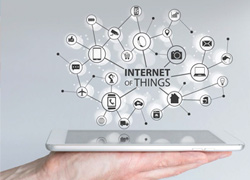CSPs’ operational and business support systems (O/BSS) are the ideal platform for a launch into the IoT market but this will only happen if CSPs get their strategy in order, writes Nick Booth
Most communications service providers could support the IoT pretty well, argues Nigel Chadwick, the chief executive of Stream Technologies. Their support systems are a great foundation, but they need a good strategy for adapting to the new challenge.
There needs to be massive attention to detail because the IoT involve mores variation in the size and types of device and in the volumes, origins and frequency of data. Subsequently everything will be different: the support, billing, technical integrations, reliability, security and data transit to end points. CSPs could offer monitoring and control, and instant detailed billing while extending services into new places, like the support of low powered wide area network (LPWAN) services.

Third party technology partners will get them there a lot quicker than if they make the mistake of trying to learn how to do it in-house.
The big IoT band is still somewhere in the future, but start working on your strategies now or you’ll miss out when the time comes, says John English, senior manager of service provider solutions for Netscout. The IoT isn’t one big basket of connected devices but distinct and wide ranging clusters from consumer to industrial applications. Being everything to everyone for free simply won’t work.
Granted, there will still be over-the-top (OTT) applications that run over your networks for free and there’s nothing a CSP can do about them. But in time those application operators will want to pay a premium for a secure and reliable network.

Chadwick says CSPs must weigh each IoT opportunity against their current markets and customer bases. Where will the valuable work be? On one hand CSPs could move up the stack, as Chadwick puts it, offering data storage or management. Or they could offer specific IoT services, such as car tracking and home alarms.
Partnerships can make CSPs agile enough to quickly ramp up the volume of business and connectivity with relatively light resources but traditionally they’ve kept things in house. There’s a “massive leveraged play for CSPs if they choose carefully”, says Chadwick.
Understanding the consumption of network resources and services, along with subscriber behaviour and experience, is the first step in exploiting the IoT. How? Create a scorecard system for network performance so you can see what their network is capable of delivering at any given time, says Cam Cullen, the global vice president of marketing at Procera Networks. This opens a range of extra up-sell and commercial opportunities if CSPs have a sufficiently detailed view of the IoT.
When there are millions of devices on your network you need a reliable indicator of how IoT services will cause spikes in network traffic. Usage patterns and reports will identify exactly where network congestion will occur and how to avoid it. Given that IoT will be used for critical civic amenities – such as transport – it has never been more important to create a consistent and low latency data throughput.
It’s the billing experience that makes CSPs so well positioned to serve the IoT model, says Paul Lalancette, the IoT Communications industry lead for Accenture Digital.
“CSPs can offer bundled services across verticals to provide complete solutions,” says Lalancette, “global players offer home kit solutions but CSPs have the local service experience with an existing customer base that trusts them.”
If a CSP runs mobile apps for enterprises, it’s qualified to create a machine-to-machine portfolio, argues Russell Doty, technology strategist and product manager at Red Hat.
Under the circumstances the simplicity of the single bill makes the CSP a credible manager for IoT.
“A standard communications infrastructure supports a wide range of use cases,” says Doty. “The IoT can reshape enterprise IT as fundamentally as did mobile and will create a similar path of standardisation. Once a standard has been agreed upon and implemented, companies will invest in advanced mobilisation but avoid vendor lock-in through proprietary IoT interfaces.”
The OSS systems of most CSPs can control multiple devices with a single system at an almost broadcast level, says Moran Lerner, the chief executive of Chirp. This smoothes the trivial tasks, overcomes the incompatibility of legacy systems and patches security holes. Many of the older protocols CSPs used for traditional communications, like SMS, can now be used to speak to a network of devices.
Many CSPs lack understanding of IoT and imagine it means building something completely new rather than use existing infrastructure. By harnessing the very old and simple technologies and devices that they own, CSPs can grab the lion’s share of the IoT rewards. |






